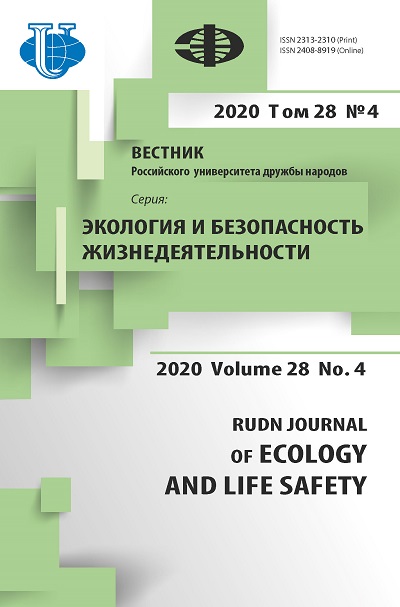Assessing the georeferencing accuracy of different amount of image stripes for linear UAV projects
- Authors: El Sheshtawy A.M.1,2, Limonov A.N.1, Gavrilova L.A.1, Elshewy M.A.1,2
-
Affiliations:
- State University of Land Use Planning
- Al-Azhar University
- Issue: Vol 28, No 4 (2020)
- Pages: 381-396
- Section: Environmetal defence
- URL: https://journals.rudn.ru/ecology/article/view/27352
- DOI: https://doi.org/10.22363/2313-2310-2020-28-4-381-396
Cite item
Full Text
Abstract
At present, the results of photogrammetric processing of images obtained from UAVs (orthophoto mosaics, digital elevation models, etc.) are widely used for environmental studies. Such materials are especially relevant and in demand for environmental monitoring of hard-to-reach objects. In addition, UAV survey materials are indispensable for impact monitoring, in which observation, assessment and forecast of the state of the natural environment in areas where hazardous and potentially hazardous (NPP) sources of anthropogenic impact are located are carried out. Regardless of the method of georeferencing of images - direct or indirect - the accuracy of the generated product is evaluated by ground control points. The purpose of this study is to assess the accuracy of photogrammetric constructions depending on the number of strips when surveying linear objects from UAVs and on the number of control points used in indirect georeferencing. Five groups of experiments were carried out during the study, three in each group with a different number of strips (from one to three). Five groups are conventionally combined into two sections. In the first section, direct and indirect georeferencing techniques were used with three locally located control points. In the second section, the method of indirect georeferencing was used with a different number of ground control points: six, twelve and thirty-four. Estimates of the accuracy of various tests have shown that an increase in the number of strips does not always lead to an increase in accuracy.
About the authors
Amr Mahmoud El Sheshtawy
State University of Land Use Planning; Al-Azhar University
Author for correspondence.
Email: amrshesht82@gmail.com
ORCID iD: 0000-0003-0668-2375
PhD student, Department of Remote Sensing and Digital Cartography, State University of Land Use Planning; teacher, Civil Engineering Department, Faculty of Engineering in Cairo, Al-Azhar University
15 Kazakova St, Moscow, 105064, Russian Federation; 15 Mohammed Abdou St, El-Darb El-Ahmar, Cairo Governorate, Arab Republic of EgyptAnatoly N. Limonov
State University of Land Use Planning
Email: limonov.anatoly@gmail.com
ORCID iD: 0000-0002-4382-5200
Candidate of Technical Sciences, Associate Professor, Professor, Department of Remote Sensing and Digital Cartography
15 Kazakova St, Moscow, 105064, Russian FederationLarisa A. Gavrilova
State University of Land Use Planning
Email: gavrilova.a.larisa@gmail.com
ORCID iD: 0000-0002-7095-3224
Candidate of Technical Sciences, Associate Professor, Dean, Faculty of Urban Cadaster
15 Kazakova St, Moscow, 105064, Russian FederationMohamed A. Elshewy
State University of Land Use Planning; Al-Azhar University
Email: mimoelshewy@gmail.com
ORCID iD: 0000-0001-8367-207X
PhD student, Department of Geodesy and Geoinformatics, State University of Land Use Planning; teacher, Civil Engineering Department, Faculty of Engineering in Cairo, Al-Azhar University
15 Kazakova St, Moscow, 105064, Russian Federation; 15 Mohammed Abdou St, El-Darb El-Ahmar, Cairo Governorate, Arab Republic of EgyptReferences
- Shahbazi M, Théau J, Ménard P. Recent applications of unmanned aerial imagery in natural resource management. Gisci. Remote Sens. 2014;51:339-365. http://dx.doi.org/ 10.1080/15481603.2014.926650
- Anderson K, Gaston KJ. Lightweight unmanned aerial vehicles will revolutionize spatial ecology. Front. Ecol. Environ. 2013;11:138-146. http://dx.doi.org/10.1890/120150
- Liu P, Chen A, Huang Y, Han J, Lai J, Kang S, Wu T, Wen M, Tsai M. A review of rotorcraft unmanned aerial vehicle (UAV) developments and applications in civil engineering. Smart Struct. Syst. 2014;13:1065-1094. http://dx.doi.org/10.12989/sss.2014.13.6.1065
- Anai T, Sasaki T, Osaragi K, Yamada M, Otomo F, Otani H. Automatic exterior orientation procedure for low-cost UAV photogrammetry using video image tracking technique and GPS information. Int. Arch. Photogramm. Remote Sens. Spat. Inf. Sci. 2012. http://dx.doi.org/10.5194/isprsarchives-XXXIX-B7-469-2012
- Bahr T, Jin X, Lasica R, Giessel D. Image registration of high-resolution UAV data: the new hypare algorithm. Int. Arch. Photogramm. Remote Sens. Spat. Inf. Sci. 2013. http://dx.doi.org/10.5194/isprsarchives-XL-1-W2-17-2013
- Boccardo P, Chiabrando F, Dutto F, Tonolo FG, Lingua A. UAV deployment exercise for mapping purposes: evaluation of emergency response applications. Sensors. 2015; 15:15717-15737. http://dx.doi.org/10.3390/s150715717
- Turner D, Lucieer A, Wallace L. Direct georeferencing of ultrahigh-resolution UAV imagery. IEEE Trans. Geosci. Remote. 2014;52:2738-2745. http://dx.doi.org/10.1109/ TGRS.2013.2265295
- Xiang H, Tian L. Method for automatic georeferencing aerial remote sensing (RS) images from an unmanned aerial vehicle (UAV) platform. Biosyst. Eng. 2011;108:104-113. http://dx.doi.org/10.1016/j.biosystemseng.2010.11.003
- Chiang KW, Tsai ML, Chu CH. The development of an UAV borne direct georeferenced photogrammetric platform for ground control point free applications. Sensors. 2012;12:9161-9180. http://dx.doi.org/10.3390/s120709161
- Turner D, Lucieer A, Watson C. An automated technique for generating georectified mosaics from ultra-high resolution unmanned aerial vehicle (UAV) imagery, based on structure from motion (SfM) point clouds. Remote Sens. 2012;4:1392-1410. http://dx.doi.org/10.3390/rs4051392
- Chiang KW, Tsai ML, Naser ES, Habib A, Chu CH. New calibration method using low cost MEMS IMUs to verify the performance of UAV-borne MMS payloads. Sensors. 2015;15:6560-6585. http://dx.doi.org/10.3390/s150306560
- Ai M, Hu Q, Li J, Wang M, Yuan H, Wang S. A robust photogrammetric processing method of low-altitude UAV images. Remote Sens. 2015;7:2302-2333. http://dx.doi.org/10.3390/rs70302302. [CrossRef] [Google Scholar]
- Wu CT, Hsiao CY, Chen CS. An assessment of errors using unconventional photogrammetric measurement technology with UAV photographic images as an example. J. Appl. Sci. Eng. 2013;16:105-116.
- Remondino F, Fraser C. Digital cameras calibration methods: considerations and comparisons. Proceedings of the ISPRS Commission V Symposium on Image Engineering and Vision Metrology. Dresden; 2006. p. 266-272.
- Rieke-Zapp D, Tecklenburg W, Peipe J, Hastedt H, Haig C. Evaluation of the geometric stability and the accuracy potential of digital cameras-comparing mechanical stabilisation versus parameterisation. ISPRS J. Photogramm. 2009;64:248-258. http://dx.doi.org/10.1016/j.isprsjprs.2008.09.010
- Yang Y. Robust estimation for dependent observation. Manuscr. Geod. 1994;19:10-17.
















